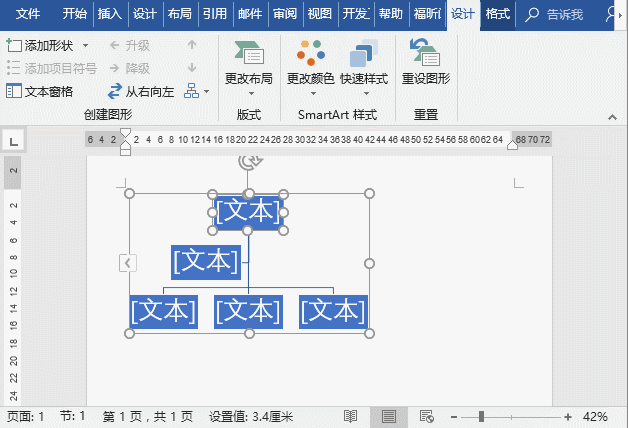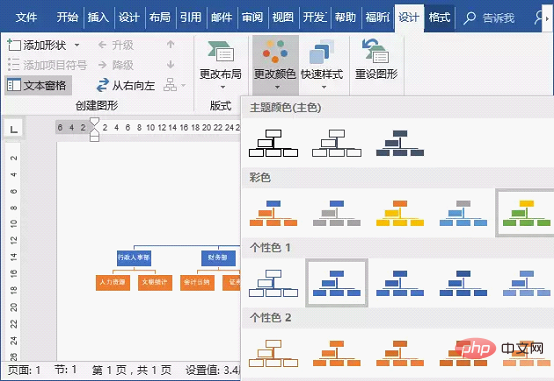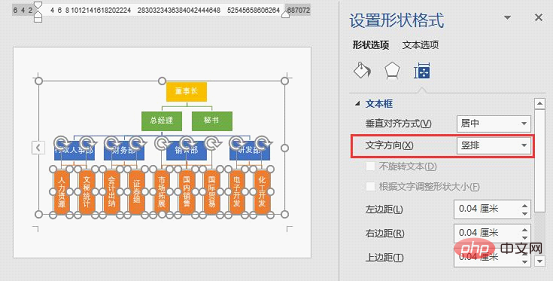 Topics
Topics
 word
word
 Practical Word skills sharing: How to use smartart to create an organizational chart
Practical Word skills sharing: How to use smartart to create an organizational chart
Practical Word skills sharing: How to use smartart to create an organizational chart
In the previous article "Sharing practical Word skills: How to use Word to make an electronic official seal", we learned how to use Word to make an electronic official seal. Today we are going to talk about how to use smartart to create an organizational chart, come and take a look!

#How to make an organization chart in Word? Many people may have the same question, so today I would like to share it with you and let’s learn how to make an organization chart in Word.
Organizational chart, also known as organizational structure chart, is the most basic structural basis for an enterprise's process operation, department setup, and functional planning. Common organizational structure forms include centralized, decentralized, linear, and Matrix formula etc.
It shows the company and department structure in a graphical form. The organizational chart can provide a clear overview of the various relationships within the organization. For example, the picture below is a common organizational chart.

To make the above picture, I think many children may draw it with their bare hands, add text boxes, insert shapes, add straight lines, and finally adjust, beautify, and combine.
However, if changes are needed one day, they need to be separated one by one and readjusted, which is really time-consuming and labor-intensive. Therefore, as an office worker, it is necessary for us to master the quick skills of making a company organizational chart.
Today I will introduce to you a very magical tool in Word, it is called SmartArt. Use it to quickly create the perfect organizational chart.
How to do it?
Step 1: First, according to the needs of the picture, click the "Paper Orientation" button in the [Layout]-[Page Setup] group, and then select The desired paper orientation, e.g. landscape.

Step 2: Then enter the organizational name of each department hierarchically in the Word document. Then use the [Ctrl A] key to select all text, the [Ctrl C] key to copy or the [Ctrl X] key to cut the text.

Step 3: Position the cursor where you want to insert SmartArt, and click the "SmartArt" button in the [Insert]-[Illustration] group. Open the "Select SmartArt Graphic" dialog box, select "Hierarchy" in the left list of the dialog box, and select "Organization Chart" in the middle list. Click the "OK" button, and a default organizational structure diagram will be generated in the document.


Tips: When selecting a SmartArt graphic, the current one will be displayed in the list box on the right. A brief description of the selected SmartArt.
Step 4: Click the [Design]-[Text Graphics]-[Text Pane] button to bring up the text pane. Then press the [Ctrl A] key combination to select all the text pane content and press [Delete] to delete the default frame content. Then paste the previously copied or cut text content into the pop-up text box to generate an organization chart.

Tips: As you can see from the above operations, we can edit the content in the organizational chart in the "Text Pane", or click the right "Text" in each shape on the side to change the content.
Step 5: If you need to add subordinate positions to the architecture diagram. For example, to add "Secretary" below "President", you can first select "Chairman", right-click the mouse, and select [Add Shape]-[Add Shape Below] in the pop-up menu.

Step 6: Add a new blank text box and enter the text "Secretary" in it.

Tips: If you want to add a position or assistant at the same level, the operation method is the same as above. Of course, if you want to adjust the position level, you can directly press the [Tab] key in the "Text Pane" to downgrade; press [Shift Tab] to upgrade the settings.
Step 7: If you feel that the current architecture diagram layout is not good-looking, we can adjust its layout. For example, here we adjust the layout of positions under each department. You can first select the department text box, click the [Design]-[Create Graphics]-[Layout] button, select the layout method in the pop-up menu, and select "Standard" here.

Step 8:Then use the same method to adjust the layout of each department in turn, the effect is as shown in the figure.

Step 9: Select the organizational chart, click the "Change Color" button in the [Design]-[SmartArt Style] group, and click The color of the architecture diagram can be changed in the pop-up list.

The effect is as shown in the picture:

Step 10:We can also press Hold down the [Ctrl] key to select multiple positions at the same time. For example, here select all positions under the department, right-click the mouse, and select "Format Shape" in the pop-up menu.

Step 11: You can set the "text direction" in the open task pane. Here we set the text direction to "vertical" , and then use the mouse to drag the text box in the architecture diagram to adjust the width and height to obtain a vertical text box.

Production completed! The effect is as follows.
Tips: If you think this layout doesn’t look good, we can adjust it. Select the entire organization chart and select a layout in the [Design] [Layout] list box. If you want to delete a certain position, select the position and directly press the [Delete] key to delete it.
SmatrAart can not only be used to create architecture diagrams in Word, but can also be used in excel and PPT~~~ and the methods are similar.
Recommended tutorial: "Word Tutorial"
The above is the detailed content of Practical Word skills sharing: How to use smartart to create an organizational chart. For more information, please follow other related articles on the PHP Chinese website!

Hot AI Tools

Undresser.AI Undress
AI-powered app for creating realistic nude photos

AI Clothes Remover
Online AI tool for removing clothes from photos.

Undress AI Tool
Undress images for free

Clothoff.io
AI clothes remover

Video Face Swap
Swap faces in any video effortlessly with our completely free AI face swap tool!

Hot Article

Hot Tools

Notepad++7.3.1
Easy-to-use and free code editor

SublimeText3 Chinese version
Chinese version, very easy to use

Zend Studio 13.0.1
Powerful PHP integrated development environment

Dreamweaver CS6
Visual web development tools

SublimeText3 Mac version
God-level code editing software (SublimeText3)

Hot Topics
 1386
1386
 52
52
 How to cancel automatic word wrapping in word
Mar 19, 2024 pm 10:16 PM
How to cancel automatic word wrapping in word
Mar 19, 2024 pm 10:16 PM
When editing content in a word document, lines may automatically wrap. If no adjustment is made at this time, it will have a great impact on our editing and make people very headache. What is going on? In fact, it is a problem with the ruler. Below, I will introduce the solution to how to cancel automatic word wrapping in word. I hope it can help everyone! After opening a Word document and entering text, when you try to copy and paste, the text may jump to a new line. In this case, you need to adjust the settings to solve this problem. 2. To solve this problem, we must first know the cause of this problem. At this time we click View under the toolbar. 3. Then click the "Ruler" option below. 4. At this time we will find that a ruler appears above the document with several conical markers on it.
 Detailed explanation of how to display the ruler in Word and how to operate the ruler!
Mar 20, 2024 am 10:46 AM
Detailed explanation of how to display the ruler in Word and how to operate the ruler!
Mar 20, 2024 am 10:46 AM
When we use Word, in order to edit the content more beautifully, we often use rulers. You should know that the rulers in Word include horizontal rulers and vertical rulers, which are used to display and adjust the document's page margins, paragraph indents, tabs, etc. So, how do you display the ruler in Word? Next, I will teach you how to set the ruler display. Students in need should quickly collect it! The steps are as follows: 1. First, we need to bring up the word ruler. The default word document does not display the word ruler. We only need to click the [View] button in word. 2. Then, we find the option of [Ruler] and check it. In this way, we can adjust the word ruler! Yes or no
 How to add handwritten signature to word document
Mar 20, 2024 pm 08:56 PM
How to add handwritten signature to word document
Mar 20, 2024 pm 08:56 PM
Word documents are widely used due to their powerful functions. Not only can various formats be inserted into Word, such as pictures and tables, etc., but now for the integrity and authenticity of the files, many files require a manual signature at the end of the document. It sounds like this How to solve complex problems? Today I will teach you how to add a handwritten signature to a word document. Use a scanner, camera or mobile phone to scan or photograph the handwritten signature, and then use PS or other image editing software to perform necessary cropping on the image. 2. Select "Insert - Picture - From File" in the Word document where you want to insert the handwritten signature, and select the cropped handwritten signature. 3. Double-click the handwritten signature picture (or right-click the picture and select "Set Picture Format"), and the "Set Picture Format" pops up.
 How to set page margins for Word
Mar 19, 2024 pm 10:00 PM
How to set page margins for Word
Mar 19, 2024 pm 10:00 PM
Among office software, Word is one of our most commonly used software. The text documents we produce are generally operated with Word. Some documents need to be submitted in paper version as required. Before printing, the layout must be set before it can be presented. produce better results. So the question is, how do you set page margins in Word? We have specific course explanations to help you solve your doubts. 1. Open or create a new word document and click the "Page Layout" menu on the menu bar. 2. Click the "Margins" button of the "Page Setup" option. 3. Select a commonly used page margin in the list. 4. If there are no suitable margins in the list, click "Custom Margins". 5. The "Page Setup" dialog box pops up, enter the "Margins" option respectively.
 How to draw a dotted line in word
Mar 19, 2024 pm 10:25 PM
How to draw a dotted line in word
Mar 19, 2024 pm 10:25 PM
Word is a software that we often use in our office. It has many functions that can facilitate our operations. For example, for a large article, we can use the search function inside to find out that a word in the full text is wrong, so we can directly replace it. Make changes one by one; when submitting the document to your superiors, you can beautify the document to make it look better, etc. Below, the editor will share with you the steps on how to draw a dotted line in Word. Let's learn together! 1. First, we open the word document on the computer, as shown in the figure below: 2. Then, enter a string of text in the document, as shown in the red circle in the figure below: 3. Next, press and hold [ctrl+A] Select all the text, as shown in the red circle in the figure below: 4. Click [Start] on the top of the menu bar
 Where is the shading setting in word?
Mar 20, 2024 am 08:16 AM
Where is the shading setting in word?
Mar 20, 2024 am 08:16 AM
We often use word for office work, but do you know where the shading settings are in word? Today I will share with you the specific operation steps. Come and take a look, friends! 1. First, open the word document, select a paragraph of text paragraph information that needs to be added with shading, then click the [Start] button on the toolbar, find the paragraph area, and click the drop-down button on the right (as shown in the red circle in the figure below) ). 2. After clicking the drop-down box button, in the pop-up menu options, click the [Border and Shading] option (as shown in the red circle in the figure below). 3. In the pop-up [Border and Shading] dialog box, click the [Shading] option (as shown in the red circle in the figure below). 4. In the filled column, select a color
 Specific steps to delete down arrow in Word!
Mar 19, 2024 pm 08:50 PM
Specific steps to delete down arrow in Word!
Mar 19, 2024 pm 08:50 PM
In daily office work, if you copy a piece of text from a website and paste it directly into Word, you will often see a [down arrow]. This [down arrow] can be deleted by selecting it, but if there are too many such symbols, So is there a quick way to delete all arrows? So today I will share with you the specific steps to delete the downward arrow in Word! First of all, the [Down Arrow] in Word actually represents [Manual Line Break]. We can replace all [Down Arrows] with [Paragraph Mark] symbols, as shown in the figure below. 2. Then, we select the [Find and Replace] option on the menu bar (as shown in the red circle in the figure below). 3. Then, click the [Replace] command, a pop-up box will pop up, click [Special Symbols]
 Do you know how to sum a Word table?
Mar 21, 2024 pm 01:10 PM
Do you know how to sum a Word table?
Mar 21, 2024 pm 01:10 PM
Sometimes, we often encounter counting problems in Word tables. Generally, when encountering such problems, most students will copy the Word table to Excel for calculation; some students will silently pick up the calculator. Calculate. Is there a quick way to calculate it? Of course there is, in fact the sum can also be calculated in Word. So, do you know how to do it? Today, let’s take a look together! Without further ado, friends in need should quickly collect it! Step details: 1. First, we open the Word software on the computer and open the document that needs to be processed. (As shown in the picture) 2. Next, we position the cursor on the cell where the summed value is located (as shown in the picture); then, we click [Menu Bar





